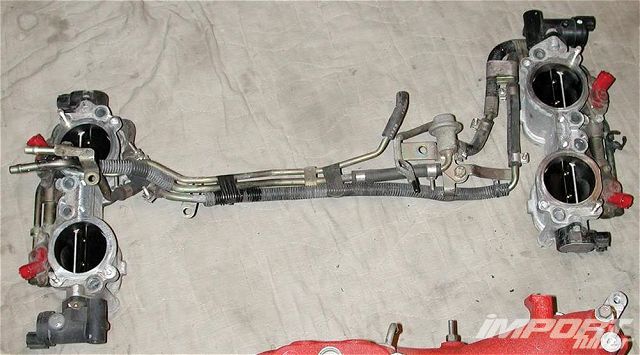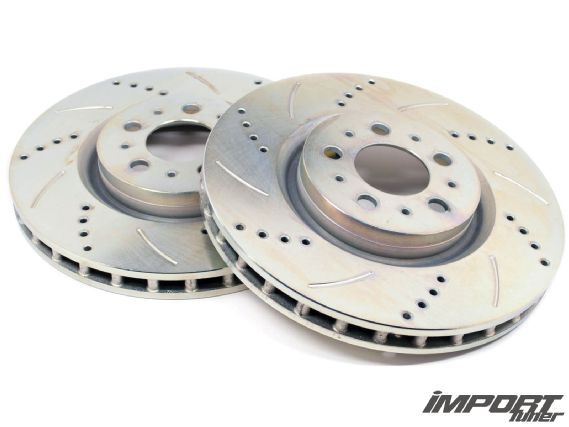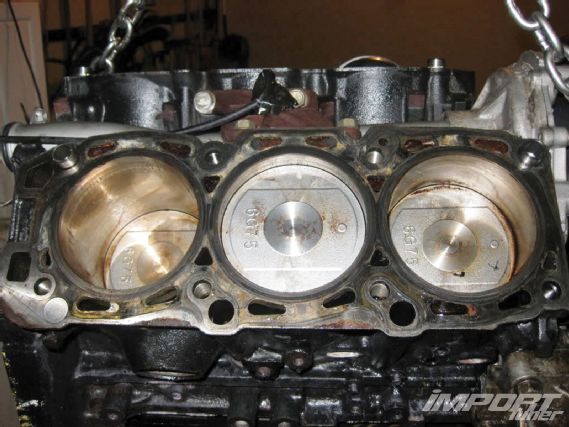 |
| www.beyondthedyno.com/blogs/eric
Got a burning question or simply need some advice with problems you've encountered while wrenching on your current/future projects? Ask our automotive guru Eric Hsu anything--literally, he's going to answer every single question, as long as it's automotive related.
Got a tech question? Send it to questionit@importtuner.com
 | October 2013 Question IT
| October 2013 Question IT
Mazda MZR Turbo Upgrade
I own a '06 Mazdaspeed 6. I purchased this car because I wanted a turbo AWD sedan that was not a WRX or an Evo and was slightly more refined. I looked at S4's for some time as well, but the maintenance costs kept me away. In any case, I don't regret the purchase. The car has been fantastic! I currently have 105K on the odometer and have been contemplating a turbo upgrade. I have installed all the bolt-ons available for this car-Corksport turbo-back exhaust with 3-inch MagnaFlow hi-flow cat; CP-E TMIC, upgraded injector pump and injector seals; Cobb intake and turbo inlet pipe; tuned AccessPort (Stage 2 19 psi); and stock K04 turbo. I have an ACT clutch and street flywheel installed. Although one ACT clutch has failed already, ACT replaced everything at no cost. I have a SURE rear differential brace installed because the stock piece was prone to breaking. While installing that brace I also upgraded the rear sway bar to a Whiteline rear bar with upgraded Mazdaspeed rear links. I am also running ITV22 Denso plugs, with a Vibrant oil catch can installed.
I have been running synthetic oil since I bought the car with 55K on the odometer. This is my first turbocharged car so I'm doing every bit of research I can to understand which turbo I should purchase. All info so far has lead me to a GT3071R. I have heard that using this turbo will require that I rebuild the motor--perhaps, given the mileage, I'm already at the rebuild point. In any case I have thought about installing a BNR Stage 3 Turbo, which is (I think) a modified K04 turbo with a GT2871 compressor wheel. This is a non-ball bearing turbo. Obviously I have seen great longevity with the K04 turbo. Despite the Internet squawk about the turbo seals prone to failure, I have yet to experience such a disaster.
My goals for the car are 100 percent streetability with as much power as I can muster on 93-octane pump gas. I feel like I am making a good amount of power already, although I have never dyno'd the car. I'm not so thrilled about a bigger turbo, considering the later spool characteristics. Is there such a considerable performance difference between ball bearing turbos and journal-bearing turbos to qualify for their higher cost? And, if so, will a ball bearing turbo have the longevity that I have experienced with my current journal bearing turbo? I have heard that I may need to add a particle filter on the turbo's oil lines to assure the longer life of the ball bearing turbo. I'd like to not rebuild the motor, but if a turbo upgrade on a motor that has seen this many miles is just toying with the inevitable, I may need to save my money until I can do everything at once.
In the event a full motor build happens, what are some ways I can address my fueling needs? Since this car is direct injected, there seems to be many opinions on what should be done. I keep hearing about using meth injection but I would prefer to not go this route, or is my prejudice getting the best of me?
Any information you can provide as far as turbo sizing would be great. Despite public opinion about the power this motor can make in this car, I think most neglect to appreciate the torque numbers many are seeing. The driveline seems to be grossly over built, and let's be honest, I don't know of many turbo AWD sedans with double wishbone suspensions.
-MP, via importtuner.com
The MS6 is a great grocery getter with balls. It's practical and not too expensive to maintain either, being a Mazda. While its AWD system isn't as advanced or aggressive as the Evo or STI's, the MS6 does offer AWD grip, which is a hell of a lot more grip than any front-wheel-drive car has to offer.
It sounds like you've been headed up the upgrade path correctly addressing everything that needs addressing, and a turbo upgrade is definitely the next upgrade to enhance the package. I work with Evan Goldberg at Cobb, and he's the resident Mazdaspeed guru and hard parts design engineer at Cobb. While I'm intimately familiar with the DISI engine itself, I usually ask Evan questions about the MS3 and MS6 platforms because he knows it all. Evan's personal ride is a MS3 with a GT3582R turbo that makes 400 hp at the wheels on the modified factory fuel system without meth injection on 93-octane. Since he has no plans on using meth injection, he is contemplating downsizing in the future. Evan said to me, "The 3071 is really the right turbo for the MS cars." However, he does recommend a built bottom end with forged pistons and billet rods to be paired with the 3071.
A GT2871R with 52 trim compressor wheel would offer better bottom end response and would be better suited to the power limit of a stock bottom end. Or, if your budget allows, a GTX2863R could provide greater top end power with better response than a GT2871R. Alternately, the GTX2867R could work with both your stock bottom end and grow with a built engine when you have saved enough money to build the bottom end. The GTX2867 would respond better and generate more top end power than the GT3071R. The aerodynamics of the GTX series' compressor wheels is newer and improved from the older GT designs. They command a premium due to the extensive design and testing efforts Garrett put into the GTX series turbos. The standard GTs would be well suited if you are on a budget, of course.
There's nothing wrong with sleeve bearing turbos either, but turbo manufacturers generally put their higher technology wheels and components into their higher costing ball bearing turbos. Ball bearings also reduce transient response times to a degree due to reduced friction over a sleeve and thrust bearing system. Ball bearings combined with newer wheel designs with better aerodynamics and lower inertia are why newer turbo designs, such as the Garrett GTX and BorgWarner EFR, perform so well.
A pre-filter on the turbo oil inlet hose is unnecessary as long as you change your engine oil and filter regularly.
As with any engine, the quality of tuning is key to durability. Whatever you decide on doing for an upgrade, be sure to visit a Cobb Pro-Tuner to have your AccessPort and engine tuned to its maximum potential while maintaining reliability.
Subaru Stumbling Issues
Many '08-and-newer Subaru STI owners are experiencing issues with their cars stumbling around 2,800 rpm. My '12 STI is no exception, as it seems to have the same problem. The car is currently running a Cobb SF intake and Stage 1 AccessPort map.
I've heard so many different solutions/reasons as to why this happens, like:
1) Water hammer effect
2) Some owners say to fit the earlier FPR
3) Some owners say to swap the FPR out for a JDM STI one
4) I've even heard that the STI fuel pumps don't have enough pressure or that the static pressure needs to be 3 bar vs. 2.5 bar.
Can you set the community right and inform us why this happens?
-Rob, via importtuner.com
 | October 2013 Question IT STI Fuel Pressure Regulator System
| October 2013 Question IT STI Fuel Pressure Regulator System
The factory STI fuel pressure regulator system uses a semi-deadhead system that attempts to recirculate the fuel already at the front of the car while only returning a portion of it. Unfortunately this system has caused notable hesitation in some cars. The problem is exacerbated with larger fuel injectors for some reason. The simple fix is to install a '04-07 STI fuel pressure regulator to replace the '08-and-newer fuel pressure regulator assembly. It does require some hose cutting and fabrication, but if you're looking for a direct bolt-in kit, Cobb Tuning will have a complete kit with premade hose assemblies that should be released before the end of the year.
Wow . . . Just Wow
I have a tech question I hope you can help answer. My son recently received a '87 Buick LeSabre that was in his grandfather's will. While I know it's not an import car, my son does love it, and it means the world to him as he was very close to his grandfather. He does, however, want to do an import theme and possibly make this a track car, as it does have potential and will be very different. We want to do a taillight conversion using taillights from a late '80s Civic or Accord. Are taillight conversions hard? We never did one and are hearing mixed reviews. We might even do a headlight conversion as well. Is there anything we need to know? Also, are the locks that hold the bulbs universal or are they specific to every make vehicle?
-Jon, via importtuner.com
As you've discovered, there isn't much aftermarket parts support for the '87 Buick LeSabre. It was a never a car that was extensively modified. Chances are your son will have to find parts from another GM platform that can be adapted. As for the taillights and headlights, that's going to be all bodywork and will require a considerable degree of sheetmetal fabrication. If you're asking how, I'm sure you or your son should try. Light sockets are not always universal; lightbulbs are as long as you use the correct type. If you're going to attempt it, I would recommend cutting the sockets out of the car you are going to get the taillights and headlights from and wiring them into the LeSabre's electrical harnesses. Good luck-you're going to need a ton of it.
Stopping on a Dime
I have a question about drilled or slotted brake rotors. What direction are the holes or slots in the rotor supposed to travel? Is it when the vehicle is moving forward and the brake caliper comes in contact with it that the outer part of the slot comes in contact first then moves toward the inner part of the rotor, or the other way around and the inner part comes in contact first then moves toward the outside? Or does it even matter? I have looked online and saw both answers, and when I flip through the pages of your magazine I see vehicles with the rotors both directions (on different cars). If you could shed some light on this for me it would be greatly appreciated.
-Jeffrey Martellini, via importtuner.com
 | October 2013 Question IT Rotors
| October 2013 Question IT Rotors
I did a quick Google search for "slotted rotors correct way" and found the answer on Zeckhausen Racing's website in about 1.2 seconds. Zeckhausen Racing is a well-known performance and racing brake components dealer. Their instructions on this page are correct: zeckhausen.com/how_to_properly_install_rotors.htm. Slots are installed with the outer section of the slot coming in contact with the brake pad first. The correct installation of drilled rotors is not the direction of the drilling, since that can be random depending on the manufacturer. It depends on the direction of the internal cooling vanes (if any). Most drilled rotor suppliers will have some kind of identification for left and right rotors (e.g. stickers or labels). If not, then a straight vaned rotor can be installed either way. A direction vaned rotor must be installed with the inner edge of the vane approaching the caliper first in the direction of rotation.
Torque Plate Necessity?
I am in the middle of doing a 6G75 V-6 motor build in my '08 Eclipse GT, and I've been following your June issue's "Seven Tips to Build a Motor". I am an active member of the 4G Eclipse forums, and some people say a torque plate isn't needed. I've seen them in many pictures of builds in magazines with them and was highly recommended from my machinist so I spent the extra $500 to have a custom one made from BHJ. Was this a good investment? Also, how important is it to have the same head gasket installed while honing? The Head gasket was another big item on your list but once again there are none for this platform. We used a stock head gasket because a custom Cometic was going to cost $2,500, but I may have finally talked that company into making them for cheaper.
-Thomas Drake
 | October 2013 Question IT Torque Plate
| October 2013 Question IT Torque Plate
It all depends on how precise you want your machining to be. The word necessary is really relative. Do you want your engine to be machined precisely for a high-horsepower build? Then, yes, your torque plate was a good investment. If you want to rebuild the motor to go another 100,000 miles, and you don't care too much about how much oil it burns, then perhaps you don't need one. The fact is that cylinder bores distort a considerable amount when a cylinder head is torqued to the cylinder block. This is a fact. It is not a rumor. It is not an assumption. It is an absolute fact. The factory Mitsubishi machinists can finish hone the block without torque plates, because the engineers already designed the honing process around a procedure that will yield near ideal precision for the factory piston. For mass production, it is in Mitsubishi's best interest to do this since they can reduce labor and machining time and your local engine machinist does not know Mitsubishi's process. Plus, if you're using an aftermarket forged piston, then the required clearances are entirely different from the factory piston anyway.
Different head gasket designs can also cause the bore to distort differently. So yes, it is also ideal to finish-hone the block using the type of gasket you plan to use during final assembly and a torque plate.
